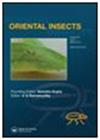木蜂(膜翅目:蜂科)对木蜂的生物学及季节影响
IF 0.6
4区 农林科学
Q4 ENTOMOLOGY
引用次数: 0
摘要
摘要本研究旨在探讨木蜂养殖中棘蝇的侵害程度。棘蛉是木蜂的幼虫寄生性昆虫。样本采集于野外、自然筑巢地和人工筑巢地。对2019年1月至2020年6月木蝇类的季节消长情况进行了调查。棘蛉的生物学揭示了其生命周期的不同阶段。在该地区发现了侵染木蜂的两种棘蝇,即红斑棘蝇(Physocephala rufipes)和scutellata。红豆豆的总发育期为130 ~ 185天,黄柳豆的总发育期为136 ~ 191天。6 ~ 8月的季节发病率较高,为25 ~ 38%,侵染7 ~ 11天后死亡。结果表明,2019年和2020年,黄褐褐皮小蠊的侵染率分别为15.96%和16.79%,高于黄褐褐皮小蠊的14.29%和14.66%。在两种木蜂中,红皮假蜂的发病率(64-71.11%)高于褐皮假蜂(28.29-36.93%)。紫红色假单孢虫在迪马普尔的感染率最高(29.68%),而黄斑假单孢虫在Peren的感染率最高。本文章由计算机程序翻译,如有差异,请以英文原文为准。
Biology and seasonal incidence of Physocephala (Diptera: Conopidae) on Carpenter Bees (Hymenoptera: Apidae)
ABSTRACT Studies were conducted to explore the extent of conopid fly infestation in carpenter bee rearing. Conopid flies are larval parasitoids of carpenter bees. The samples were collected from fields, natural nesting sites and artificially domiciled nests. The seasonal incidences of conopid flies in Xylocopa were observed from January 2019 to June 2020. The biology of conopid flies revealed different stages of their life cycle. Two species of conopid fly, Physocephala rufipes and Physocephala scutellata were identified to infect carpenter bees in this region. The total development period of P. rufipes ranged between 130 and 185 days while it was 136–191 days in P. scutellata. Seasonal incidences showed higher infestation during June to August which ranged between 25 and 38% and the infested foragers died after 7–11 days of infestation. A comparative seasonal incidence of P. rufipes and P. scutellata revealed higher infestation in X. tenuiscapa (15.96% and 16.79%) over X. fenestrata 14.29% and 14.66% during 2019 and 2020. The incidence of P. rufipes was higher in both the carpenter bees (64–71.11%) as compared to P. scutellata (28.29–36.93%).The highest incidence of P. rufipes was recorded from Dimapur (29.68%) while P. scutellata infestation was higher in Peren.
求助全文
通过发布文献求助,成功后即可免费获取论文全文。
去求助
来源期刊

Oriental Insects
生物-昆虫学
CiteScore
1.60
自引率
0.00%
发文量
34
审稿时长
>12 weeks
期刊介绍:
Oriental Insects is an international, peer-reviewed journal devoted to the publication of original research articles and reviews on the taxonomy, ecology, biodiversity and evolution of insects and other land arthropods of the Old World and Australia. Manuscripts referring to Africa, Australia and Oceania are highly welcomed. Research papers covering the study of behaviour, conservation, forensic and medical entomology, urban entomology and pest control are encouraged, provided that the research has relevance to Old World or Australian entomofauna. Precedence will be given to more general manuscripts (e.g. revisions of higher taxa, papers with combined methodologies or referring to larger geographic units). Descriptive manuscripts should refer to more than a single species and contain more general results or discussion (e.g. determination keys, biological or ecological data etc.). Laboratory works without zoogeographic or taxonomic reference to the scope of the journal will not be accepted.
 求助内容:
求助内容: 应助结果提醒方式:
应助结果提醒方式:


